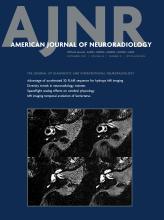Abstract
SUMMARY: Radiology has historically not been a very diverse field. Many steps have been taken in the past decade to increase diversity in the field and make it more inclusive. This study shows the relative trends specifically in neuroradiology trainees, and the need for reassessment and further steps to increase diversity.
ABBREVIATION:
- IMGs
- International Medical Graduates
Embracing diversity and inclusion has been emphasized by the American Society of Neuroradiology (ASNR) to enhance our collective ability to improve quality and excellence.1 Several steps have been taken by the ASNR to increase diversity and the representation of women and underrepresented minorities.1 These are especially important given the historical lack of diversity in radiology across all practice levels.2,3 The trends in diversity specific to neuroradiology are not known. We undertook this study to assess trends in diversity among neuroradiology trainees from 2014–2015 to 2021–2022.
MATERIALS AND METHODS
All data were obtained from publicly available, nonidentifiable, summarized databases and approval from the institutional review board was not applicable.
The American Medical Association and the Association of American Medical Colleges administer the National Graduate Medical Education Census and maintain a database on training programs accredited by the Association Council for Graduate Medical Education.4 The Graduate Medical Education results from 2014–2015 to 2021–2022 were accessed for demographic information for neuroradiology trainees in the United States.5 The sex and racial and ethnicity breakdowns were extracted, including Black/African American, Caucasian/White, Asian, Hispanic, and others. Data were also analyzed for US doctors of medicine, International Medical Graduates (IMGs), graduates of Canadian medical schools, and graduates in doctor of osteopathic medicine. The 2-tailed t test was used to calculate the statistical difference between groups, with P < .05 as a cutoff for significance.
RESULTS
In 2021–2022, there were 90 Association Council for Graduate Medical Education–accredited programs with 253 neuroradiology trainees, of which 51 (20.2%) were women. In 2014–2015, women constituted 49/166 (23%, P = .490) neuroradiology trainees (Fig 1). The proportion of women among trainees in the past 8 years has ranged between 18% and 25%.
Sex distribution in neuroradiology trainees 2015–2022.
In 2021–2022, Blacks or African Americans constituted 8/253 (3.2%) and Hispanics were 5/253 (2.0%) of all neuroradiology trainees. The corresponding proportions in 2014–2015 were 3/215 (1.4%, P = .207) for Blacks and 9/215 (4.2%, P = .162) for Hispanics. The proportion of Blacks has ranged between 1.4% and 4.4%, and for Hispanics, it has ranged between 2% and 8.2% in the past 8 years (Fig 2).
Racial distribution of neuroradiology trainees 2015–2022.
Asians constituted 71/253 (28%) trainees in 2021–2022 and 73/215 (34%, P = .166) in 2014–2015. The proportion of Asians has ranged between 25% and 34%.
Whites constituted 108/253 (42.7%) trainees in 2021–2022, down from 116/215 (54%, P = .015) in 2014–2015. The proportion of Whites has ranged between 35.4% and 61.8%.
There were 32.7% of trainees in 2020–2021 and 23.3% (P < .001) in 2021–2022 identified as “other/unknown for race/ethnicity,” higher compared with previous years (Fig 2).
The proportion of IMGs has increased from 44/215 (20.5%) in 2014–2015 to 75/253 (29.6%, P = .023) in 2021–2022 and has ranged between 13.7% and 29.6% (Fig 3).
Proportion of US MDs, DOs, IMGs and Canadian graduates. US MD indicates United States doctor of medicine.
DISCUSSION
Diversity in neuroradiology trainees is even less compared with overall radiology residents and has not shown improvement with time. While the recent proportion of women is 27%, with Blacks at 4%, and Hispanics at 6% for radiology residents nationwide,2 the corresponding proportions in neuroradiology are 20% (P = .016), 3.2% (P = .575), and 2% (P = .009), respectively. The proportion of Whites has decreased from 54% to 43% during the study period.
Academic radiology has seen an increase in the proportion of women in faculty ranks, especially at more senior levels and as department chairs.2 Women have also seen higher representation at the leadership positions at the national level: Five of the 10 ASNR Presidents from 2010 to 2019 were women, with 3 of the 4 Presidents from 2020 to 2023 being women.3 Lack of diversity at the leadership levels was previously thought to impair the ability of our field to address the underlying causes of disparities.1 The ASNR Annual Program Committee has worked on creation of a program diversity checklist to encourage diverse and inclusive representation.1 ASNR has also taken several steps, including webinars and podcasts, to increase awareness as well as mentorship programs within neuroradiology.
Despite the aforementioned efforts and successes, the sex and racial representation at the trainee level in neuroradiology is a reason for concern. An objective analysis of the efforts being undertaken to improve diversity as well as reasons for the problem that need further addressing may be required.
IMGs provide a broad range of diversity in our society, with members from very diverse backgrounds. The proportion of IMGs in neuroradiology is higher than the national average. In 2020, IMGs constituted 14.6% of all radiology trainees.6 The proportion of IMGs in the American Board of Radiology Alternate Pathway and the proportion staying in academic neuroradiology need further study.
A limitation of this study is the increase in the number of trainees reported as other/unknown for race/ethnicity in the Association of American Medical Colleges data set.
CONCLUSIONS
This study highlights the need for greater diversity in the field of neuroradiology and reassessment of the steps needed for this strategic imperative.
Footnotes
Disclosure forms provided by the authors are available with the full text and PDF of this article at www.ajnr.org.
- Received June 2, 2023.
- Accepted after revision June 22, 2023.
- © 2023 by American Journal of Neuroradiology















